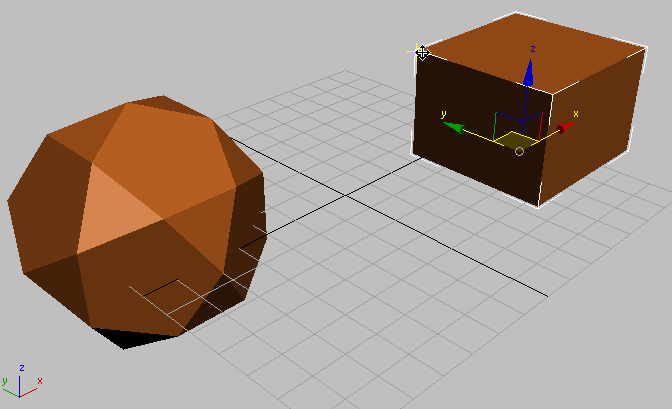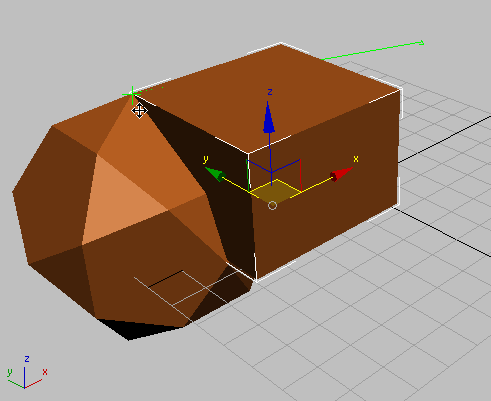The buttons on the Snaps Toggle flyout provide control over the range of 3D space where snaps are active. A wide variety of snap types is available from the Snaps dialog, which you can use to activate different snap types as you work.

2D, 2.5D, 3D Snaps flyout
Object snapping lets you snap to specific portions of existing geometry during creation and transforms of objects or sub-objects. You can also snap to the grid, and you can snap to tangents, midpoints, pivot points, face centers and other options.
The mode you choose maintains its state when you switch levels.
Transforming Around Snap Points
When snapping is on and Auto Key is off, rotations and scales occur about the snap point. For example, if you're using Vertex snapping and you're rotating a box, you can rotate it about any of its corner vertices. See To use snaps to move an absolute distance: below.
When Auto Key is on and either Select And Rotate or Select And Scale is active, the Snaps Toggle button is disabled, and rotation and scaling take place about the pivot point of the object.
Snap Handle When Moving an Object
When 2D, 2.5D, or 3D snaps are turned on and the Move tool is active, the Move gizmo shows a small circle at its center.

A circle at the center of the Move gizmo shows that snaps are active.
Not only does the circular handle indicate that snaps are active, it helps increase the accuracy of snaps, compared to releases prior to Autodesk 3ds Max 2012. You can use the gizmo controls as before, or drag the handle itself: In either case, 3ds Max shows the original position of the object, and by default a rubber-band line stretches from the original position to the new destination. When you drag the snap handle or the Move gizmo, the axis center is the start snap point.

The green line shows start and destination points.
When start and destination points are snapped or aligned, the color of the snap points and rubber band changes from Snap Point Active (default=green) to Snap Point Snapped (default=yellow).
 Colors panel, choose Elements
Colors panel, choose Elements  Snaps.
Snaps.
Dragging from the snap handle is equivalent to using the Snap Options Use Axis Center As Start Snap Point that was available in older versions of 3ds Max. In addition, you can use other snap points on the object that you are moving. For example, when snapping to vertices, the following illustrations show that you can snap from a vertex on the object you are moving.

Vertex snap: Snapping from the upper-left corner of the box.

Snapping the upper-left corner of the box to a vertex on the dodecahedron.
 Move cursor is visible when you click. Otherwise, you might deselect the object you are trying to move.
Move cursor is visible when you click. Otherwise, you might deselect the object you are trying to move.
Using the snap handle or the Move gizmo corresponds to the toggle Use Axis Constraints, or to  (Snaps Use Axis Constraints Toggle) on the Axis Constraints toolbar
(Snaps Use Axis Constraints Toggle) on the Axis Constraints toolbar
To turn snap off during a transform:
To use snaps to move a relative distance:
 (Snaps Toggle).
(Snaps Toggle).
 (Selection Lock Toggle) on the status bar.
(Selection Lock Toggle) on the status bar.
To use snaps to move an absolute distance:
 (Snaps Toggle).
(Snaps Toggle).
Example: To rotate a box around a vertex using snaps:
 (Auto Key) is off.
(Auto Key) is off.
 Select the box.
Select the box.
 (Select And Rotate).
(Select And Rotate).
 Grid And Snap Settings. Turn on Vertex and turn off Grid Points.
Grid And Snap Settings. Turn on Vertex and turn off Grid Points.
 (Selection Lock Toggle) on the status bar.
(Selection Lock Toggle) on the status bar.
 (Use Transform Coordinate Center) (hold the mouse down on Use Pivot Point Center to open the flyout).
(Use Transform Coordinate Center) (hold the mouse down on Use Pivot Point Center to open the flyout).
 2D Snap
2D Snap 2.5D Snap
2.5D SnapThe cursor snaps only to the vertices or edges of the projection of an object onto the active grid.
Suppose you create a grid object and make it active. You then position the grid object so you can see through the grid to a cube further off in 3D space. Now with 2.5D set, you can snap a line from vertex to vertex on the distant cube, but the line is drawn on the active grid. The effect is like holding up a sheet of glass and drawing the outline of a distant object on it.
 3D Snap
3D SnapThis is the default tool. The cursor snaps directly to any geometry in 3D space. 3D snapping lets you create and move geometry in all dimensions, ignoring the construction plane.
Right-click this button to display the Grid and Snap Settings dialog, which lets you change snap categories and set other options.